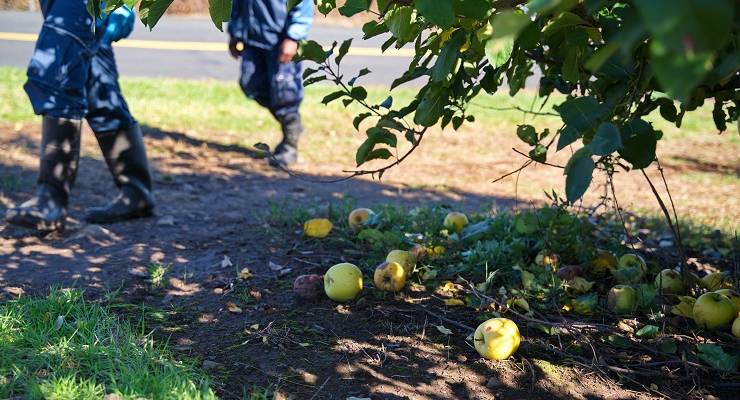
Farmers have been getting worried for months. As the summer fruit-picking season looms, closed borders and travel restrictions mean Australia’s horticulture sector, which depends heavily on seasonal, migrant labour, will really struggle.
And that will mean a summer with fewer Australian fruit and vegetables on supermarket shelves. Consumers paying more for less. And although politicians are finally confronting the crisis — proposals to send refugees and school leavers to farms have gotten traction on both sides of the aisle — it could all be too little too late.
Higher prices, less produce
It’s no secret the horticulture sector can’t function without migrant workers — a mix of working holiday visa makers (often backpackers from Europe) and undocumented labourers — but the pandemic stopped them coming.
The numbers paint a worrying picture of what that could mean for the sector. An interim report released by a parliamentary inquiry into the working holiday program found the number of visa holders under the system halved from 140,000 in March to 70,000 in June.
Modelling from Ernst and Young suggests a shortage of 15,000 farm workers in Victoria alone, which could mean price hikes of up to 60%.
But vice-president of the Victorian Farmers Federation Emma Germano told Crikey those were probably conservative estimates. The summer could be so bad that it causes deeper, longer pain for growers.
Before the pandemic hit, the horticulture sector was hoping to expand. That’s now off the table.
“There are people who are already pulling permanent plantations,” Germano says.
“You can’t just turn an orange tree on and off. If we start seeing permanent tree crops being pulled out, by the time they’re replanted there’s four to five years lost.”
General manager of the National Farmers’ Federation Ben Rogers told the inquiry: “The industry will be confronted with a labour crisis the likes of which it has never seen before.”
Time for solutions
In trying to fill gaps left by migrant workers, the horticulture sector faces the unenviable task of upending structural forces decades in the making.
In the past few weeks, there has been a rash of proposals — of varying merit — to address shortages.
The inquiry’s interim paper suggested a “Have a gap year at home” campaign to attract school leavers who might otherwise be swanning around the Mediterranean. Some farmer groups want people on JobSeeker to pick fruit to get payments. Coalition and Labor MPs support a plan to make farm work a path to residency for refugees.
United Workers Union’s director of farms Jannette Armstrong said although all plans should be considered, politicians needed to work out how to attract people, particularly younger workers, to the regions.
The elephant in the room
Most of the recent chatter about farm shortages has omitted what Armstrong said was the “elephant in the room”: the large contingent of undocumented migrant workers who have propped up the sector for decades.
Most are underpaid and have endured terrible working conditions, victims of a labyrinthine network of shonky labour hire contractors and migration agents.
“These workers are a very important part of the horticulture workforce, and without them we wouldn’t have the fruit we eat,” Armstrong says.
“They’ve been doing the hard yards to keep this sector growing.”
When border restrictions loosen they will come back.
Armstrong and Germano say the pandemic is the time to hit the reset button and look at visa amnesties and other processes to regularise fruit pickers’ migration.
But instead much of the conversation has focused on trying to get more Australians out to the regions.
“There’s a real romanticisation of Australian workers,” Germano says.
“But the notion that [migrants] steal Australian jobs is incorrect. They enable Australian jobs up the supply chain.”
And while it’s true that without migrants the industry will have to find ways to attract more local workers, picking fruit just isn’t a particularly attractive prospect for many Australians, despite what Agriculture Minister David Littleproud might say about earning $3800 a week.
Armstrong says the seasonal nature of work, and the lack of infrastructure in the regions, are a big barrier. But mostly it’s the horror stories of low pay and mistreatment. Last week an ABC report featured backpackers who had faced abuse, exploitation and underpayment working on farms.
“Why would young people put their hand up for that?”








Great business model and planning. Rely exclusively on an underclass that you can enslave and exploit without ever thinking the river of slavery would dry up. This, regrettably, is the standard of Australian business leadership.
The only regret of “Australian business
leadership” is that they couldn’t make that the norm for the entire workforce – though the Rodent gave it a red hot go with SerfChoiceless.“It’s no secret the horticulture sector can’t function without migrant workers.”
If I want journalism that just parrots industry spin, I’ll read the mainstream media.
Hey horticulture sector: If you can’t find labour in the middle of a recession, perhaps there’s something seriously wrong with your pay and conditions? Oh look, there is.
Imagine the shock of it, farmers having to pay decent wages for farm labour. Fruit pickers might even go all the way and form a union like the shearers did, all those years ago.
What a great idea – if that were to happen it might end up as a political party to replace the empty husk of “Labor”.
I wonder why fruit growers think it is the government’s problem to attract young people to regional areas when the issue lies with their propensity to exploit their workforce through miserly wages and conditions?
No doubt this won’t stop the dole bludger narrative from coming to the fore, with calls for the young unemployed to be press ganged into seasonal fruit picking, or face losing their equally miserly job seeker payments.
At least there is a smidgin of balance in this article.
Can someone please explain why we would want to subsidise and prop up industries that can’t pay workers decent wages? Wouldn’t the investment be better directed to industries that generate better returns without subsidy and without relying on offensively low wages?
The answer for these farmers is simple. Either pay wages and have employment conditions sufficient to attract workers or change the products they produce. In many cases farms on marginal land and which use unsustainable water need to be abandoned. Opaque subsidies, including sub-standard (sub-human?) wages, might make a few rich, but it also encourages farm development where it is not viable.
Just take a look at Singapore. In the 1960s Singapore had a huge working poor from low value sweatshops. In the 1970s they doubled their minimum wage which overnight put their low wage businesses out of business. Investment then went to high wage ventures, and the industries that developed delivered jobs with higher wages….and look where they are now!